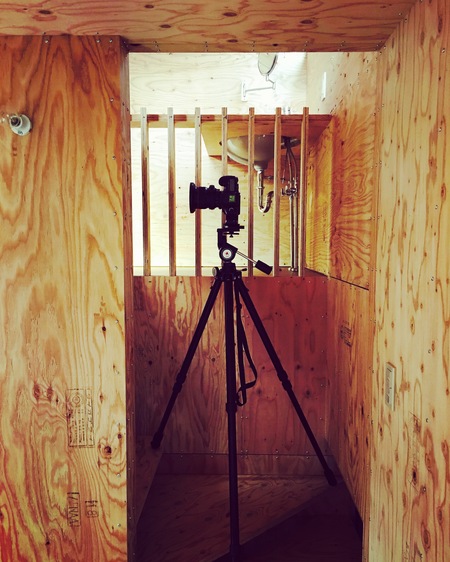建築の見方vol.1
歩き回る、とにかく歩き回る。
この建築いいな、知りたいな、や
その建築を見に行くことが目的の時は
その建築をまず体験したいと思う。
建築に対して見る点はたくさんある。
周辺の環境に対してどのように建っているか、
外観のデザイン、建築周囲の外構デザイン、
建築内部に入れるならば、エントランス、空間構成、
室内に入れるならば、内装のデザインなど。
さらに、もっと細かく見ていけば、
周辺の環境に対して、
この建築は何か調和をはかろうとしているのか、
周辺環境の問題点を解決しようとしているのか、
周辺環境から影響を受けていることは、
逆に影響を与えていることは、
なぜその建ち方をしているのか、
法的規制に対する解決方法は、
などなど、きりが無い。他の点も同じ。
最後は可能ならば実測してスケッチまでする。
が、まず体験したいと思う。
きっとそれは、学生の時に、何も無いから、知識も経験も無いから、目の前の建築から何かを得ようとした時に、とにかく、この建築はどうなっているのか、事前に資料に当たっていたとしても、自分で確かめないとはじまらない。そのためにはまず、その建築の周囲を歩き回り、建築の中に入っていき、さらに歩き回り、その建築を体験して、それで何かを感じ、考え、言葉にするしかないし、それしかできなかったから。今まで数え切れないくらいの建築を見て来たが、はじめの見方が染み付いてしまい、見たい建築の前に立つと、スイッチが入ったように突然歩き回りはじめる。
学生や20代、30代前半の頃は、写真をよく撮った。スケッチもしたが、短時間でその建築から何かを得ようとした時には、写真のフレームが有効のような気がしていたから。
なぜ短時間か?海外へ建築を見に行く時は大体、建築ツアーを利用し、ツアー終了後、そのまま日本に帰らずに延泊して、時には1ヶ月位いて、さらに見て回った。自分で見て回る時はそんなに短時間な制限は無いが、ツアーだと1ヶ所15〜30分で見学なんてこともよくあった。ツアーを利用したのは、その方が効率良く、短い期間で多くの建築が見られるから。だから、1ヶ所の滞在時間が短いのは仕方がないことだが、15〜30分は短すぎる。
建築家が長い時間を掛けて設計し、施工したものを、例え、規模が小さくても、15〜30分で理解するのは難しい、大した建築でなければ一瞬で終わるが。
だから、最初の頃は、後でも見ることができるように写真をたくさん撮って、滞在時間の短さを補っていた。
学生や20代、30代前半の頃にはすでにデジカメはあったが、画質が今ほど良くなく、メモリ容量も少なくて枚数が多く撮れないこともあり、まだフィルムカメラ全盛だった。1ヶ月位海外へ行く時にはフィルムを100本位持参し、ほとんど使っていた。
今と違って、20世紀には、建築を世の中に広めようとしたら、写真しかなかった。1枚の写真が世界中飛び回る。だから、建築家は1枚の写真でその建築の全てがわかるようにする。ここから見れば、その建築の全てがわかる場所をつくる。
その場所を探し出すのにも写真を撮る意味があった。すなわち、20世紀の建築家はイメージの中に写真のフレームがあり、常にそのフレームを意識しているのではないかと、段々と思うようになっていたから、写真を撮ることでその建築の理解が深まると考えていた。
そして、短期間でたくさんの建築を見て、たくさん写真を撮っていると、建築家や建築の規模や用途や立地条件、国や地域が違っても、写真のフレームにおさめて見るという行為で、1つの絶対的な基準ができ、それによって対等に比較することが可能になるので、これは建築の良し悪しを見て判断する時に非常に役立ち、とても勉強になった。建築の視覚情報に対する扱い方はこれで随分鍛えられた。
"Viewpoint of architecture vol.1"
Walk around, walk around anyhow.
This building is nice, I want to know,
When it is the purpose of going to see that architecture
I would like to experience the architecture first.
There are many points of view to architecture.
How it is built against the surrounding environment,
Exterior design, external design around the building,
If you put it inside the building, entrance, space composition,
If you put it in the room, interior design etc.
Furthermore, if you look more closely,
For the surrounding environment,
Is this building trying to harmonize something?
Is it trying to solve the problem of the surrounding environment,
It is affected by the surrounding environment,
On the other hand,
Why are they doing that way,
As a solution to legal restrictions,
There are no scratches, such as. The other points are the same.
Finally, measure if possible and sketch.
But first I want to experience.
Surely it is because there is nothing at the time of a student because there is nothing, knowledge and experience, so when we tried to get something from the architecture in front of us, anyway, I was hitting the materials in advance as to what is going on with this architecture Even if you do not check it yourself it will not start. To do that, we first wandered around the architecture, entered into the architecture, further walked around, experienced the architecture, so we had to do something, think, and make it, so we could only do it. Although I have looked at countless constructions until now, the first view gets stuck and I stand before the architecture I want to see, it suddenly begins to walk like a switch enters.
Students, 20s, early 30s, I took a lot of pictures. I did sketching, but when I tried to get something from that architecture in a short time, I felt that the frame of the photo was valid.
Why for a short time? When I go abroad to go to see the architecture, I usually use a construction tour, staying overnight without going home as it is after the tour, occasionally around a month and watched further. There is no such a short time when looking around by oneself, but on a tour it often happened that visiting in 15 to 30 minutes at one place. We used the tour because it is more efficient, because many buildings can be seen in a short period of time. So it is unavoidable to have a short stay in one place, but 15 to 30 minutes is too short.
Even if the scale is small, it is difficult for an architect to design and implement it for a long time, it is difficult to understand in 15 to 30 minutes, but if it is not a large construction it ends in a moment.
So at the beginning, I took a lot of photos to make it possible to see it later, and compensated for the short staying time.
Students, 20s, early 30s already had digital cameras, but the picture quality was not as good as it is now, memory capacity is too small to take many pictures, and still film cameras were at its best. When I go overseas for one month I brought 100 films and used mostly.
Unlike now, in the 20th century, when trying to spread architecture to the world, there were only pictures. One photo fly around the world. So, the architect makes a single picture to show you all of the building. From here, I will make a place to understand all of the building.
It was meaningful to take pictures to find the place. In other words, architects of the 20th century had a frame of photograph in the image, and it seemed to me that it was always conscious of the frame, taking photographs deepens the understanding of the architecture I thought.
And if you look at a lot of architecture in a short period and take a lot of pictures, even if the size and use of the architect and the building, the location conditions, the country and the region are different, the act of seeing in the frame of the picture , One absolute standard can be made, which makes it possible to compare equally, so this was very helpful for judging by looking at the good or bad of the architecture and it was a great learning experience. This way of handling the visual information of the architecture has been trained considerably with this.


コメント